Saturday, August 2, 2025. Annette’s Roundup for Democracy.
If Hamas ends its control of Gaza, would a Palestinian state finally happen?
Macron’s recognition of a Palestinian state seems to have set off a domino effect among nations. For example, the UK seems ready to recognize Palestine next.
What will this lead to? It seems to have led to 22 Arab countries calling for Hamas to step down in Gaza.
The article below 👇 outlines present prospects and roadblocks to a two state solution.
Arab States Call for Hamas to Disarm Amid Push for a Palestinian State.
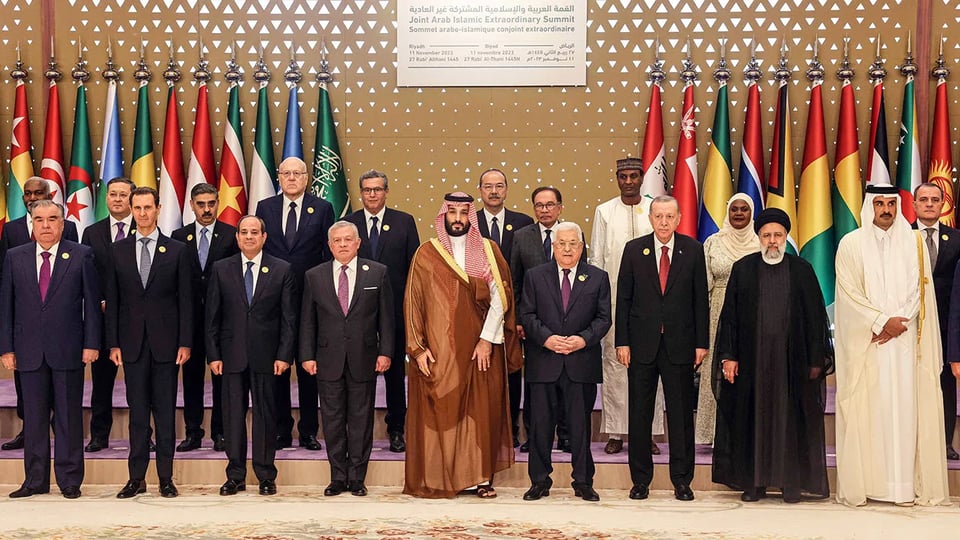
“Hamas must end its rule in Gaza,” reads a declaration endorsed by the 22 member nations of the Arab League.
The world’s Arab countries for the first time have joined unanimously in the call for Hamas to lay down its weapons, release all hostages and end its rule of the Gaza Strip, conditions that they said could help the establishment of a Palestinian state.
The surprise declaration, endorsed on Tuesday by the 22 member nations of the Arab League, also condemned Hamas’s Oct. 7 attacks on Israel, which set off the devastating war in Gaza. The statement came at a United Nations conference in New York on a two-state solution to end the decades-long conflict between Israelis and Palestinians.
“In the context of ending the war in Gaza, Hamas must end its rule in Gaza and hand over its weapons to the Palestinian Authority, with international engagement and support, in line with the objectives of a sovereign and independent Palestinian state,” said the declaration.
It was also signed by all 27 European Union states and 17 other countries.
The declaration called for the deployment of “a temporary international stabilization mission,” invited by the Palestinian Authority, which administers part of the Israeli-occupied West Bank, and “under the aegis of the United Nations.”
Many Arab leaders have working relations with Hamas and rule over populations that are deeply committed to the Palestinian cause. That has made them reluctant to break publicly with the group and to normalize relations with Israel, despite pressure from Western allies like the United States. Qatar hosts Hamas’s political office and some of its political leaders, and has acted as a mediator between the group and both Israel and the United States.
John V. Whitbeck, an international lawyer who has advised the Palestinian negotiating team in talks with Israel and has been working on the conflict for nearly 40 years, said he was not aware of a similar declaration having been made by Arab states in the past. But he noted that most Arab governments are opposed to movements that politicize Islam “and even those who might sympathize with armed resistance would feel that Hamas must be eliminated militarily and politically for the West to be fully engaged in ending the occupation.”
It remains unclear whether Hamas would heed the call of the Arab League. Hamas has so far demonstrated no willingness to voluntarily surrender its weapons or give up control over Gaza. Its initial response to the declaration was mixed but did not suggest a significant shift.
“Any effort made at the international level to support our Palestinian people and their legitimate rights is appreciated and welcomed,” the group said in a statement on Thursday demanding “unconditional international recognition” of an independent Palestinian state.
The Hamas statement did not directly respond to the call to disarm. “The Palestinian situation is an internal affair of our people,” it said.
Hamas called for reforms of the Palestine Liberation Organization, which represents Palestinians internationally and is led by the Palestinian Authority president, Mahmoud Abbas. It also demanded presidential, legislative and other elections “based on national and democratic foundations without any preconditions.”
At the United Nations, the high-level conference on a two-state solution, cosponsored by France and Saudi Arabia, unfolded as reports of starvation in Gaza continued to arrive. Images of small children and babies dying of hunger have set off global outrage against Israel for preventing humanitarian aid from entering the territory at the scale needed to avert severe food shortages.
The conference, which started on Monday and ended on Wednesday, drew widespread support. Representative of 125 U.N. member states took part, delivering speeches in support of a Palestinian state and urging Israel to commit to a two-state solution.
Analysts said that while many challenges remained — first and foremost the lack of support from Washington — the attempt to resurrect the idea of a Palestinian state was notable.
“Any effort to return international focus to the two-state solution is laudable, especially after almost two years of war and suffering between Israelis and Palestinians,” Max Rodenbeck, Israel-Palestine director at the International Crisis Group, said in a statement before the conference. “However, rhetorical support needs to be matched by practical steps, as the practical possibility for creating a Palestinian state on the ground has been ebbing for years, and under the current Israeli government faces stubborn hostility.”
Israel and the United States denounced the conference, saying that it was premature. The conditions on the ground — a continuing war, Israeli hostages still being held captive and militant groups still operating in Gaza and the West Bank — did not allow for a permanent peace or Palestinian statehood.
“No token recognition and no U.N. resolution will change the basic fact that there are those in the world who fight terrorists and extremist forces and then there are those who turn a blind eye to them,” said the Israeli Ambassador to the U.N., Danny Danon.
Israeli leaders, including Prime Minister Benjamin Netanyahu, have said the declarations on Palestinian statehood reward Hamas’s actions, make it harder to reach a cease-fire in Gaza, and endanger Israeli security.
Hamas, in its statement, expressed a similar sentiment about the calls for normalizing relations with Israel that were part of the declaration that emerged from the conference. “Talk about integrating the Zionist entity into the region is a reward to the enemy for its crimes,” it said.
Last week, France’s president, Emmanuel Macron, announced that his country would recognize a Palestinian state and would formalize it in September. Britain soon followed suit, announcing that it would recognize a Palestinian state in September if there was no cease-fire agreement in Gaza.
Other countries have indicated their willingness to recognize a Palestinian state ahead of the annual U.N. General Assembly in the fall. Among them are Australia, Canada, Finland, Malta, Portugal and New Zealand.
A document called the “New York Declaration,” which provides a phased road map for ending the nearly 80-year conflict between Israelis and Palestinians and the creation of a Palestinian state, was circulated among U.N. member states, who have until September to endorse it before the General Assembly. (New York Times)
Our poor economy is suffering and getting worse daily.
The May jobs report was revised from 144,000 to 19,000. The June jobs report was revised from 147,000 to 14,000. Yet when both reports were first released, they beat estimates. Wall Street celebrated, and Trump claimed credit. We now know both reports were actually huge misses!
— Peter Schiff (@PeterSchiff) August 1, 2025
WSJ: Trump's tariffs (esp aluminum) and trade deals are killing Ford, the largest US automaker. And the 4 biggest US-based carmakers collectively paid $2.5 billion in additional tariff costs in the second quarter alone: pic.twitter.com/PCgWpC71Ze
— Scott Lincicome (@scottlincicome) August 1, 2025
The labor market is showing big cracks that were invisible just weeks ago
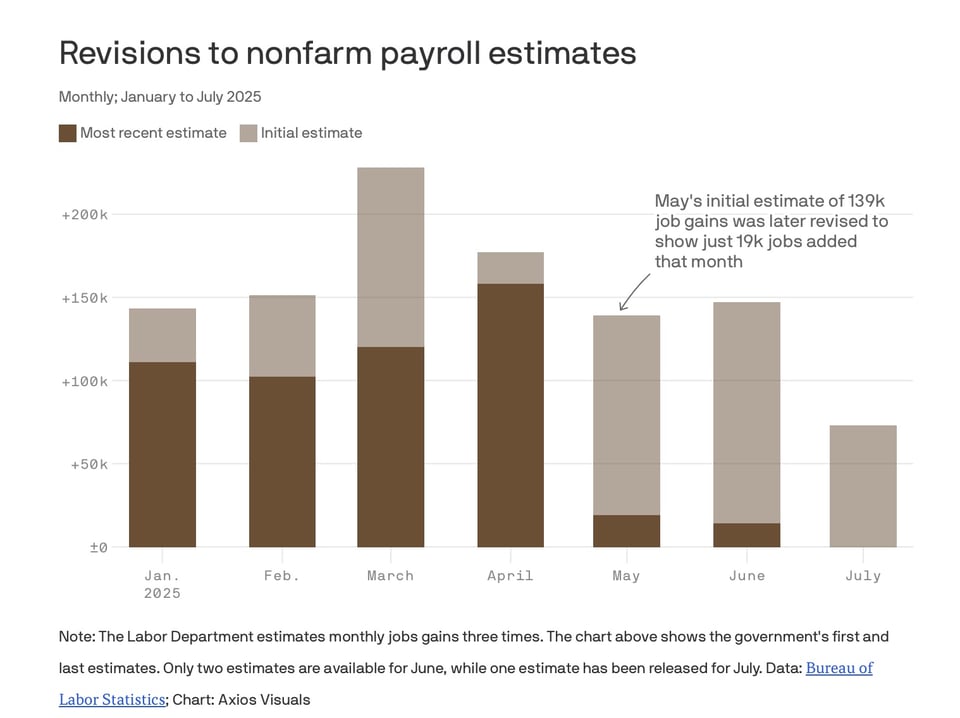
America's remarkably resilient labor market was a mirage. Hiring came to a screeching halt in the last few months, suggesting more underlying economic weakness than it seemed.
Why it matters: It's rare that a single report drastically shifts our understanding of the economy's health, but that's what happened Friday at 8:30am ET.
As of 8:29am, the official data pointed to a steady-as-can-be job creation through June, and analyst forecasts had it continuing in July.
Now, the largest two-month negative revisions on record — second only to May 2020 — point to a virtual flatlining of job creation in May and June. The July number also came in softer than expected.
The result: An average of only 35,000 jobs were added per month from May through July. That's the weakest non-pandemic three-month job creations since 2010.
Between the lines: Policymakers who have been assuming that the economy is chugging along fine will suddenly need to rethink their assumptions.
By the numbers: The economy added just 73,000 jobs in July. But the real shocker is the massive downward revision to prior months' data that shows employment has barely budged since April.
There were 19,000 jobs added in May, not the 144,000 gains that were initially reported. In June, the economy added 14,000 jobs, well below the initial estimate of 147,000 jobs.
The unemployment rate ticked up as well, to 4.2% from 4.1%, though that keeps it in the low, narrow range where it has been all year.
What they're saying: "Today's report, coupled with sharp downward revisions to the prior two months, makes it clear: job growth has stalled," Olu Sonola, head of U.S. economic research at Fitch Ratings, wrote in a note Friday.
"The labor market has now shifted from a low-hiring, low-firing environment to one characterized by virtually no hiring."
The intrigue: The economy is in the midst of population shifts as the Trump administration cracks down on immigration. That might help explain the huge revisions; people who are deported, or who stay away from their workplace to avoid raids, do not show up on payrolls.
It also might explain why hiring is stalling but the jobless rate didn't deteriorate nearly as much; companies can't hire workers who are not available.
The labor force participation rate, the share of adults with a job or looking for one, is 62.2% as of July — a half-percentage point lower than the same period a year ago.
Flashback: In response to a question from Neil earlier this week, Federal Reserve chair Jerome Powell said that the unemployment rate might be a more reliable indicator of the labor market's health.
"The main number you have to look at now is the unemployment rate," Powell said on Wednesday, and added that demand for workers has slowed but so has the number of workers the economy needs to add to keep the unemployment rate steady.
For the record: "This jobs report isn't ideal," Council of Economic Advisors chair Stephen Miran told CNN on Friday morning.
But, Miran said, "it's all going to get much, much better from here," pointing to more certainty on fiscal and trade policy.
The bottom line: The labor market is showing big cracks that were all but invisible just weeks ago.(Axios)
Applications for jobless benefits inch up for 1st time in 7 weeks, layoffs remain low - ABC News https://abcnews.go.com/Business/wireStory/us-applications-jobless-benefits-inch-time-7-weeks-124240472
The number of Americans filing for jobless benefits inched up modestly last week as business continue to retain staff despite economic uncertainty around U.S. trade policy.
WASHINGTON -- The number of Americans filing for jobless benefits inched up modestly last week as business continue to retain staff despite economic uncertainty around U.S. trade policy.
The Labor Department reported Thursday that jobless claims for the week ending July 26 ticked up by 1,000 to 218,000, less than the 225,000 new applications analysts forecast. Applications for unemployment aid are viewed as representative of layoffs.
It was the first time in seven weeks that benefit applications rose, although layoffs remain at historically low levels.
The four-week average of claims, which evens out some of the week-to-week fluctuations, fell by 3,500 to 221,000.
The total number of Americans collecting unemployment benefits for the previous week of July 19 was unchanged at 1.95 million.(Axios)
One more thing.
The Trump reaction.
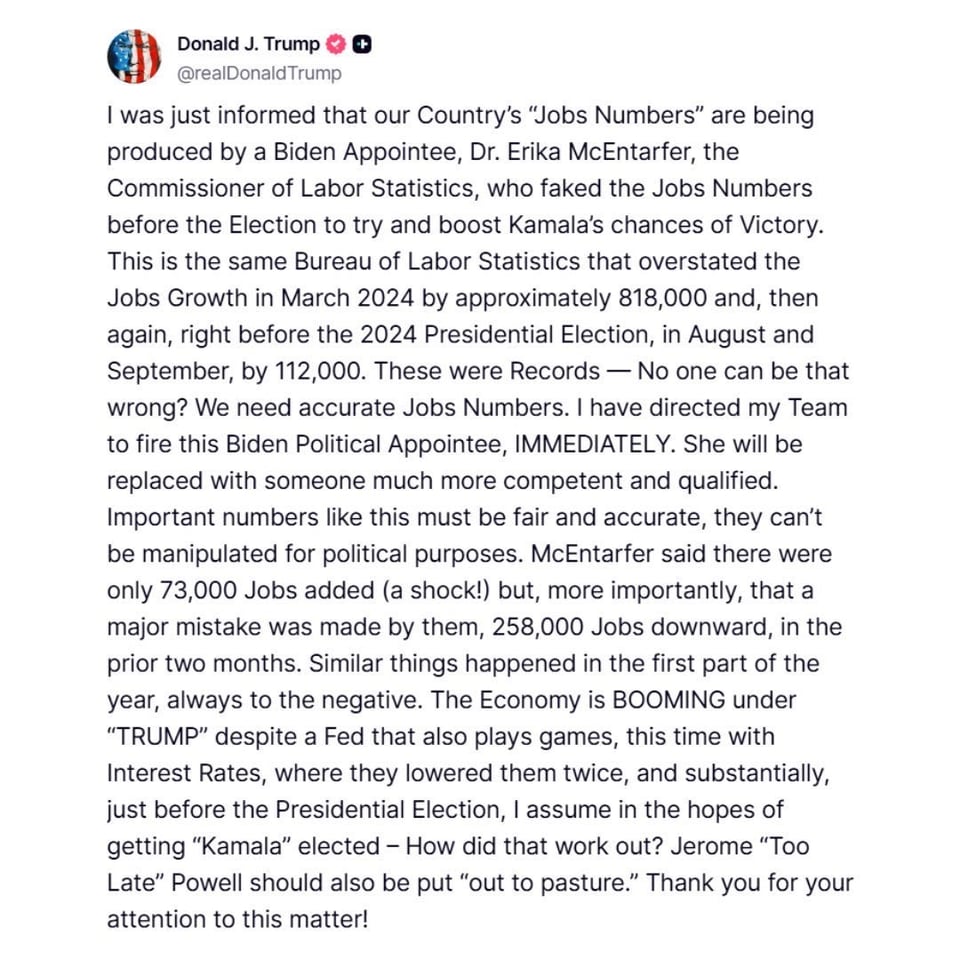
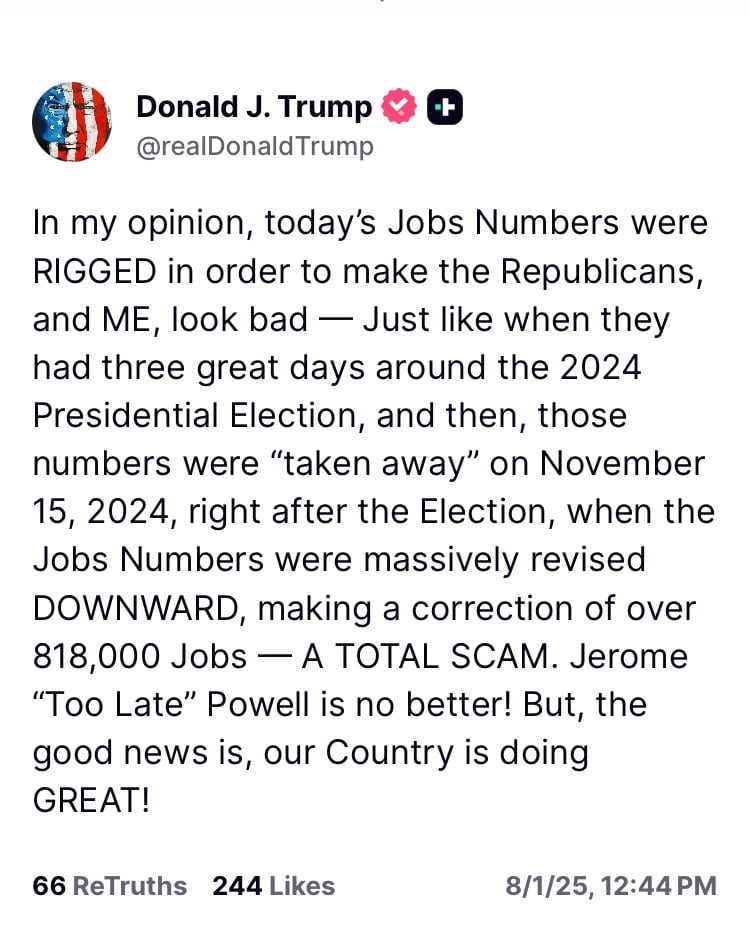
The Trump “blame others” reaction on steroids.
FLAG: Trump just directed his team to fire the Commissioner of Labor Statistics over the latest jobs numbers reports.
— Kyle Griffin (@kylegriffin1) August 1, 2025
Trump is always crazy.
Is Trump playing a new form of Russian roulette?
Is he feeling so empowered by bossing the world around with tariffs, attacking a foreign country without repercussions, damaging our universities and law firms, resisting calls for the Epstein files that he thinks he can insult Putin and his spokespeople with impunity?
Is the answer yes?
If so, depending on your belief system, 🙏 or just hold tight!
Trump, escalating war of words with Russia’s Medvedev, mobilizes two nuclear submarines - POLITICO
President Donald Trump said Friday he mobilized two nuclear submarines “to be positioned in the appropriate regions” in response to threatening comments by Russia’s former president Dmitry Medvedev.
In a post on Truth Social, Trump said he was taking that action “just in case these foolish and inflammatory statements are more than just that. Words are very important, and can often lead to unintended consequences, I hope this will not be one of those instances.”
Medvedev on Thursday referenced Russia’s nuclear capabilities amid an escalating battle on social media sparked by Trump’s latest efforts to increase economic pressure on the Kremlin in hopes of reviving diplomatic efforts to end the war in Ukraine.
While the president didn’t provide operational details, his mention of positioning nuclear submarines was remarkable, given the near certainty that there are already multiple submarines lurking in the waters around Russia.
The Pentagon typically doesn’t announce the deployment schedules or comment on current submarine operations because of the secretive nature of their missions surveilling Russian and Chinese submarines across the globe.
The entire U.S. submarine fleet is nuclear-powered, but not all submarines are capable of launching nuclear missiles. Trump did not say whether he is positioning conventional or nuclear strike-capable submarines in response to the Russians’ rhetorical aggression.
Trump’s announcement is the latest broadside in an escalating war of words between Trump and Medvedev, who is now deputy chairman of the security council of the Russian Federation — and, like the president, often inclined toward brash and even bellicose statements on social media.
It started Monday when Medvedev groused about Trump’s decision to give Russian President Vladimir Putin 10 days to change course on his war in Ukraine or risk additional economic pressure from the U.S.
“Each new ultimatum is a threat and a step towards war,” Medvedev, writing in English, posted on X.
Trump responded in a midnight post Thursday, warning Medvedev, “the failed former President of Russia, who thinks he’s still President, to watch his words. He’s entering very dangerous territory!”
Just a couple of hours later, Medvedev shot back, suggesting that Trump should imagine the apocalyptic television series “The Walking Dead” and referred to the former Soviet Union’s system for launching a last-ditch, automatic nuclear strike.
“Russia is right about everything and will continue to go its own way,” said Medvedev in a post on the Telegram messaging app. (Politico)

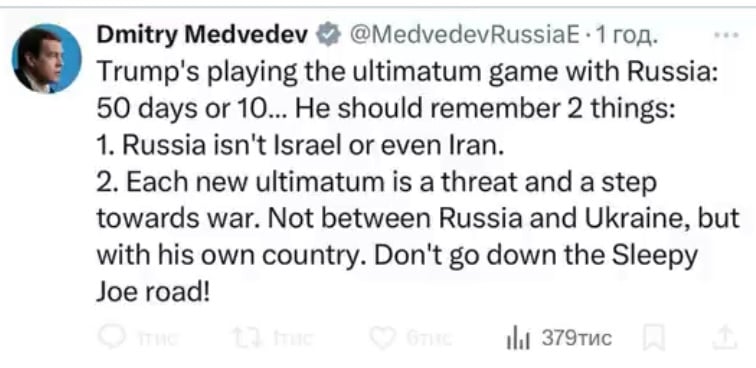

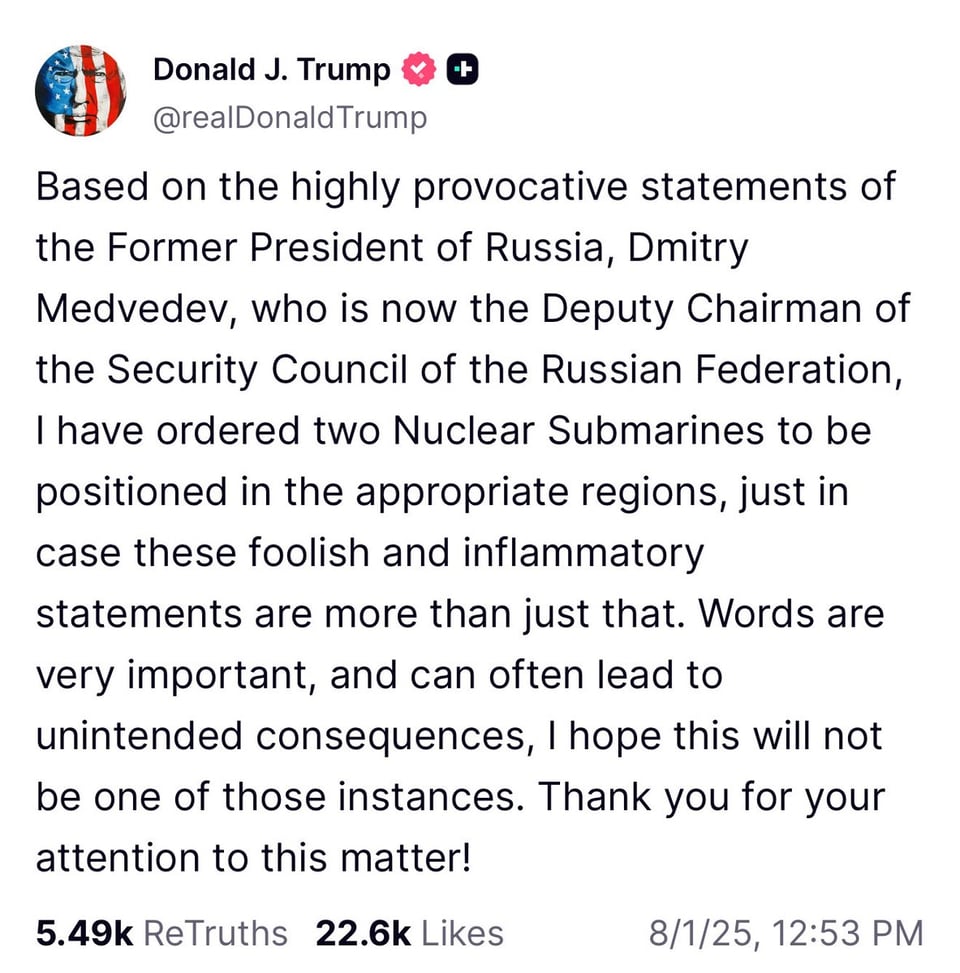
Trump’s dangerous policy was, of course, announced by Truth Social.
This will be challenging, really challenging.
Corporation for Public Broadcasting, funder of NPR and PBS, says it will end operations within months after federal budget cuts - CBS News
The Corporation for Public Broadcasting said Friday it would begin winding down its operations after its funding was eliminated by the Trump administration and Congress.
The CPB is a private nonprofit founded in 1967 that serves as a steward of funding for public media. It provides funds to 1,500 local public radio and television stations as well as PBS and NPR. It employs about 100 people.
President Trump signed an executive order in May instructing the organization to cease federal funding for PBS and NPR. In June, the House approved a White House request to claw back $1.1 billion in already appointed federal funds from the CPB. The Senate Appropriations Committee's 2026 appropriations bill eliminated funding for the CPB for the first time in over 50 years.
"Despite the extraordinary efforts of millions of Americans who called, wrote, and petitioned Congress to preserve federal funding for CPB, we now face the difficult reality of closing our operations," said CPB President and CEO Patricia Harrison in a statement. "CPB remains committed to fulfilling its fiduciary responsibilities and supporting our partners through this transition with transparency and care."
The organization said in a statement it told employees that a majority of staff positions will "conclude" when the fiscal year ends on Sept. 30, 2025. The CPB did not say exactly how many positions that was. A "small transition team will remain through January 2026 to ensure a responsible and orderly closeout of operations," the organization said.
Mr. Trump also fired three members of the CPB's five-person board in April. In response, the CPB sued, arguing the president was exceeding his authority, but that case was dropped on Friday.
Both PBS and NPR, the most high-profile public media organizations, have long been the target of Republican criticism and have been preparing for the possibility of cuts since Mr. Trump's reelection. The broadcasters receive roughly half a billion dollars in public funding through the CPB. In March, PBS CEO Paula Kerger and NPR President and CEO Katherine Maher defended their organizations from accusations of bias in testimony before a House subcommittee.
Maher warned that defunding public radio poses "a real risk to the public safety of the country." She said some NPR stations receive "more than 50% of their budget" from federal funding and may face layoffs and station closures.
Rural areas would feel the largest impacts, Maher said. Local stations also provide vital alerts in emergencies like storms, floods and wildfires.
“ Public media, public radio, public television, are a critical part of the emergency response plans of nearly half of the states in this nation," Maher said in an interview with CBS News on July 17. "If these types of emergency alerting go away, you will have fewer outlets to be able to respond in real time" to future natural disasters.” (CBS News).
What the Corporation for Public Broadcasting Shutting Down Means for PBS And NPR
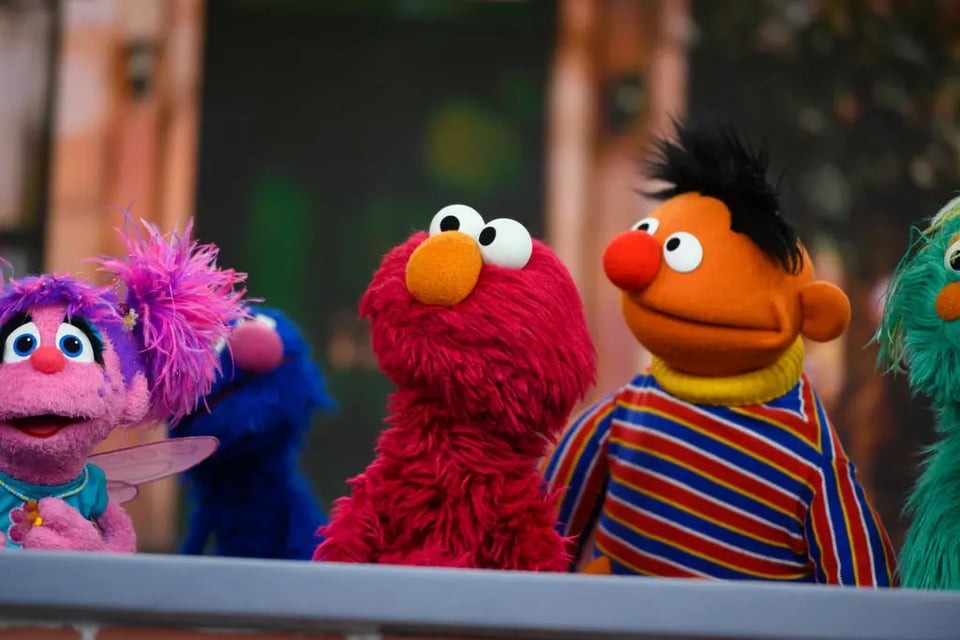
The Corporation for Public Broadcasting announced on Friday that it would begin winding down its operations after President Donald Trump rescinded $1.1 billion in funding for the nonprofit, which for decades has helped sustain NPR, PBS, and hundreds of local public media stations across the country.
“Despite the extraordinary efforts of millions of Americans who called, wrote, and petitioned Congress to preserve federal funding for CPB, we now face the difficult reality of closing our operations,” CPB President and CEO Patricia Harrison said in a statement. She added that the organization would work to support its partners during the transition “with transparency and care.”
The loss of federal support, enacted as part of a broader $9 billion rescissions package signed by Trump in July, will not bring an immediate end to national programming like PBS NewsHour or NPR’s Morning Edition. But the decision is expected to pose serious challenges to the network of smaller, often rural public broadcasters that have long depended on CPB funding for their survival.
The majority of the CPB’s roughly 100 employees will be laid off when the federal fiscal year ends on September 30, according to a press release. A smaller team will remain through January to complete financial and legal obligations, including final disbursements and the expiration of system-wide music licenses.
Harrison, who has led the CPB since 2005, called the decision to shut down “difficult” but inevitable given the scale of the funding withdrawal. “Public media has been one of the most trusted institutions in American life,” she said in her statement, “providing educational opportunity, emergency alerts, civil discourse, and cultural connection to every corner of the country.”
Here’s what to know about the funding cuts.
What is the Corporation for Public Broadcasting?
Founded in 1967 under the Public Broadcasting Act, CPB was created as a nonpartisan nonprofit to channel federal appropriations to public television and radio stations across the United States, including affiliates of PBS and NPR.
While national organizations like NPR and PBS generate their own revenue and receive only a small share of direct federal funding, their local member stations rely heavily on CPB grants. In many smaller and rural markets, federal money accounts for 25% or more of a station’s total budget.
In addition to distributing funding, the CPB also helped stations remain in legal compliance and negotiated system-wide rights, such as royalties for music and content use.
Why did Republicans push to eliminate CPB funding?
Trump and his allies have long accused NPR and PBS of leaning left politically and argued that taxpayer dollars should not support news organizations they see as ideologically biased.
“NO MORE FUNDING FOR NPR, A TOTAL SCAM!” Trump wrote on Truth Social on April 10, calling the organization “A LIBERAL DISINFORMATION MACHINE.”
After gaining unified control of Congress this year, Republicans pushed to eliminate CPB’s funding through a process known as a rescission—a formal cancellation of previously approved federal spending. The Trump Administration proposed eliminating $1.1 billion that had already been appropriated for the CPB through fiscal year 2027. Congress approved the measure in July as part of a broader $9 billion package of rescinded funds, which also included cuts to foreign aid.
Only four Republicans in both chambers of Congress broke with their party and voted with all Democrats against the package: Sens. Susan Collins of Maine and Lisa Murkowski of Alaska, and Reps. Brian Fitzpatrick of Pennsylvania and Mike Turner of Ohio.
“If you don’t like what’s going on within NPR, you think that there’s too much bias there, we can address that,” Sen. Murkowski said in a floor speech ahead of the vote. “But you don’t need to gut the entire Corporation for Public Broadcasting.” In an op-ed for the Fairbanks Daily News-Miner, she warned that the loss of CPB’s $12 million in funding for Alaska’s public stations—which covers between 30 and 70% of each stations’ budgets—would be “devastating.”
Sen. Collins expressed similar concerns: “I share the frustration with the biased reporting by NPR, and I would support defunding it. Nevertheless, local TV and radio stations continue to provide important coverage. In Maine, this funding supports the emergency alert network, coverage of high school basketball championships, a locally produced high school quiz show, and classical music stations.”
The Senate Appropriations Committee on Thursday advanced a bill that would eliminate future funding for CPB altogether—a move that Harrison said “will cause irreparable harm, especially to small and rural public media stations.”
“The absence of future funding eliminates CPB’s ability to fulfill our statutory mission—providing support to nearly 1,500 local public media stations and making needed investments that help stations serve their communities,” Harrison said before announcing the decision to wind down operations.
Despite the push in Congress to eliminate funding for public broadcasting, most Americans still support public media. A Harris Poll conducted in July on behalf of NPR found that 66% of U.S. adults favor continued federal funding for public radio, including 58% of Republicans and 77% of Democrats. 66% of respondents said that federal funding for public radio is a good value for taxpayer dollars.
What does this mean for NPR, PBS, and local stations?
National programming like PBS NewsHour, All Things Considered, and children’s shows will not disappear overnight. But the loss of CPB funding threatens the financial stability of the local stations that carry these shows—particularly those in rural or underserved regions that have long depended on federal support to stay on the air.
Without CPB grants, some stations may be forced to reduce staff, cut programming, or shut down altogether. That could have a significant impact in smaller communities, where public media stations are often among the few remaining sources of local journalism. Researchers have classified many rural areas as “news deserts” due to the decline of local newspapers and commercial outlets. Public broadcasters have filled that gap in many communities by providing access to local news coverage, educational content, and emergency alerts.
Those stations may seek new funding from state governments or private donors, but these solutions are not likely to fully replace the funding CPB provided.
The New York Times reported that roughly 120,000 new donors have contributed an estimated $20 million in annual value to public media over the last three months, according to the Contributor Development Partnership, a firm that analyzes fundraising data. Total donations this year are about $70 million ahead of last year’s pace—a sharp uptick sparked in part by public concern over the loss of federal support.
The day Congress approved the rescissions, member stations saw a spike in giving, the Times reported. Rocky Mountain Public Media in Colorado received more than 6,600 donations in one weekend, including a $500,000 gift. WUNC in North Carolina raised over $1 million. WMNF in Tampa brought in more than $280,000—unusually high numbers for both. (Time)
Get ready. Soon AI will be as familiar as email.
How I’m Preparing My Parents—And Myself—To Be Fluent in AI
On a family trip, I got locked out of the latest technologies. Here’s what it taught me about AI literacy.

The last time I visited China, seven years had passed since my previous trip. I expected some changes, but I thought the basics would still feel familiar.
I was wrong.
With the sun’s rays beating down on us outside Niushoushan Temple in Nanjing and no personally manned shop in sight, I watched my dad’s face turn to dismay trying to buy bottled water from a QR code vending machine, the lone oasis in a desolate concrete field. Trying to visit Nanjing Museum was difficult, as tickets could only be purchased through WeChat, a superapp that bundles a variety of services like chat, transport, and shopping. We didn’t have the Chinese phone number necessary to register for these local services, so we watched rideshare cars fly by, wholly inaccessible without cashless payment. Block after block, we walked to busier streets, waiting at curbs to spot a rare yellow cab.
It wasn’t just my parents—I struggled too. Despite being part of a generation that’s supposed to be tech-literate (zoomers, unite!), I felt powerless. At the neighborhood fruit shop, with change in my hands, I watched my grandpa give the cashier his phone to scan a digital wallet instead. My parents and I trailed after our relatives, like ghosts wading through a home-shaped mirage that spoke in riddles—QR codes instead of cash, screens instead of signs, silence where help used to be.
That experience has stayed with me. It showed me how fast technology can make the familiar feel foreign, and how quickly you can find yourself shut out, not just from conveniences, but from the basic rhythms of daily life, like cold water on a hot day.
Cashless payments and superapps silently eroded our access to everyday necessities, while at the same time, enabling convenience and access to services for millions (like my grandpa, ordering lunch to his door with WeChat). As it currently stands, AI might be eroding our ability to trust what we see and hear, all while allowing upwards of 700 million people to seamlessly access that on-demand career coach they may not have been able to afford, or build projects that would be much harder to achieve without the technical support AI can offer (as I’m finding, deploying my first technical project with Claude Code).
AI lets us unlock knowledge with much less friction, but hands us a contract in return. In a world where AI is no longer confined to research labs or Silicon Valley, but increasingly seeps into the cozy, familiar corners of our lives, we get to accept the increasing responsibility for exercising our own judgment. On Instagram, I see fully AI-generated people—faces, voices, gestures—delivering deceptively personal stories in ads designed to sway me and my digitally-native peers. Walking past a local music festival, I noticed vendors selling polyester T-shirts with absurd, glitchy animal faces pasted in a repeating pattern, evidently done by an AI artist. As I see AI’s fingerprints popping up in corners of the world outside of tech circles, I’m reminded of how important it is to learn about it. Though these traces may seem trivial, they point to a deeper shift in how we’ll experience the world. The more seamlessly AI blends into our daily lives, the easier it becomes to stop noticing it altogether.
Picture a near future where AI voice technology can convincingly imitate family members. Imagine healthcare guided primarily by AI triage assistants, determining whether your symptoms merit attention. Consider children bonding with AI-powered stuffed animals—available to chat even when adults aren’t around to counter false statements. Just as digital wallets replaced cash, these AI systems could replace human judgment, making invisible decisions that chip away at our trust in the world.
Yet, on the other hand, AI can be an expansive tool that allows us to show up more fully in the world—if we use it well. Whether we use it to learn from our favourite writers by analyzing their stylistic choices, build our first website with it, or use it as a career coach to dream bigger about our trajectory, it’s hard not to see how it can be helpful to expand what’s possible with our lives.
Between the repercussions and advantages of AI, I wonder: How can I make sure my parents aren’t left behind by technology again? How can I make sure I’m not left behind?
Being locked out of technology isn’t just an inconvenience. It’s about dignity, agency, and independence. It’s about the quiet, unseen grief of feeling like the world is moving on without you, and that the ground you once stood firmly on has turned into quicksand.
We've seen this before.
When the internet exploded into everyday life in the 1990s and early 2000s, my parents’ generation had to adapt to a world that suddenly expected email addresses, online forms, and digital literacy. Many did. Some learned more quickly than others, often with the patient help of their children or coworkers. Some never fully caught up, though, instead finding themselves excluded from opportunities that assumed technological competency, like being able to send a cold email or file taxes online.
The difference now is that AI moves even faster, and its work is often invisible—it outputs a seemingly palatable information soup through a complex transformation of its inputs that we can’t precisely trace. Even if you can comfortably prompt ChatGPT, you need to parse its outputs. Unlike traditional web search, which presents multiple sources to compare and weigh against each other, AI gives you a single answer—confident, coherent, and low-friction. That ease is part of what makes it so powerful, but it also makes it easy to stop questioning.
My parents have professional-level English, yet reading through a dense AI-generated response can feel overwhelming, like trying to drink from a firehose. The simple-looking interface expects you to bring not only language and prompting skills, but a whole set of unspoken literacies: how to skim and scan quickly, how to spot what’s boilerplate AI-speak, how to steer the tool with a firm yet flexible hand.
These are things I’ve learned to do almost without thinking: to abandon fluff I don’t need, to zero in on what’s useful, to keep editing my prompt until it clicks. But those instincts were shaped by years of immersion in tech culture. What’s intuitive to me after a learning curve—prompt, skim, revise—can feel murky or discouraging to someone not steeped in the same environment. And that gap isn’t about intelligence. It’s about a kind of digital competence that many people aren’t aware they need to develop.
Where the internet age demanded technical literacy, the AI age demands epistemic fluency. It’s no longer enough to know how to use the tool; we must also learn how to question and guide it. It’s more than knowing where to click—it’s about knowing what to trust.
If you’re reading this, you’re probably already a little ahead of the curve. You’re curious about AI, likely experimenting with it, too. That curiosity is a portal we can help others walk through. We have a chance, and a responsibility, to bridge the gap for those who might otherwise be locked out of the next wave of change. Anyone learning anew can and should be met with patience (that includes ourselves, by the way).
Developing fluency
Building comfort with AI doesn’t require turning anyone into deep learning experts. Instead, we can focus on training the muscles required for AI and epistemic fluency. With my parents, it was helpful to start with small, practical use cases that they could see themselves returning to. At the start, learning how to use AI, or any new technology, can feel just as clunky as learning a new language.
Here are a few ways to begin:
Navigate a complicated subject: I’ve been showing my parents how o3 can help them make sense of municipal bylaws and condo board conversations that they might otherwise get stranded in. These topics are out of my depth, too, and when I get roped in to help them, I’m relieved to explore a tool that gives us footing in a sea of legalese.
Plan a trip together: AI is great for laying the foundations of travel plans. We can, as a family, fact-check AI’s recommendations (Does that restaurant still exist? Do train tickets still cost that much?). I’m also excited to see my parents discover places that are tailored to their interests. For example, from their last trip to Spain, my dad learned he loves Antoni Gaudí’s architectural style. He could ask o3 to dive more into Gaudí’s work, and discover similar architectural styles he might be into in other parts of the world.
Generate or improve a piece of writing: AI can be a thoughtful assistant for formal communication, in the workplace and beyond. This is a great opportunity to hone in on what we love about the way we express things, and what word choices feel most natural and true to us. It also allows us to expand our repertoire for handling unfamiliar or nuanced situations—even when we’re still figuring out how we want to show up in them. In my parents’ case, it’s helped them draft messages to their condo board and communicate assertively. At the same time, they know to cross-reference what’s being generated with the original source (in this case, the municipal bylaw site) to make sure the draft was citing factual information. Because AI can easily create polished sounding content that’s plain wrong, we can remember to maintain some healthy skepticism with its outputs.
Experiment with an AI voice app: This is a really great way to show family members how impressive these tools (Sesame is a popular one) have become at generating human-sounding voices, and how strong they already are at replicating speech patterns. With that awareness, we can then ask: What still sets our voices apart? Maybe it’s an inside joke, the way someone laughs, or the unique quirks of someone’s intonation or phrasing.
Explore creative play: You can take this in any direction you want, like generating fun images together with ChatGPT-4o or image generation experimentation site Google Whisk for your family WhatsApp group chat. It’s a good reminder that AI can be a source of joy and expression, not just efficiency. And when something looks off or feels uncanny, it’s a chance to ask: What details are we tuning into? What is it triggering within us?
Stepping into the future—together
My parents taught me how to live and thrive in the world they knew. Now, it’s my turn to walk alongside them into a world that will look drastically different 20 years from now. All the while, I’m seeing my friends’ children grow up with AI, seeking out ChatGPT Voice Mode or Google Home for endless conversations like they’re a friend. The computer lab classes of my generation taught us how to use word processors and search engines. The digital literacy classes of tomorrow will be preparing children for an era of cheap, easily deployed intelligence—where prompting is a core skill, and having the discernment to know what “good” looks like across mediums (text, voice, visuals) matters more than ever.
AI is a tool we’re all still learning to wield. It’s also one that will keep evolving, requiring ongoing humility, curiosity, and care. Helping each other navigate the AI age isn’t just about teaching skills. It’s about protecting agency and dignity as the tides change. It's about building bridges across generations, so no one we love has to stand alone at the gates of a future they helped create. (Vivian Meng, Every.to)
Hope your weekend and mine are uneventful. Unless something requires communication, see you on Tuesday! 🤞